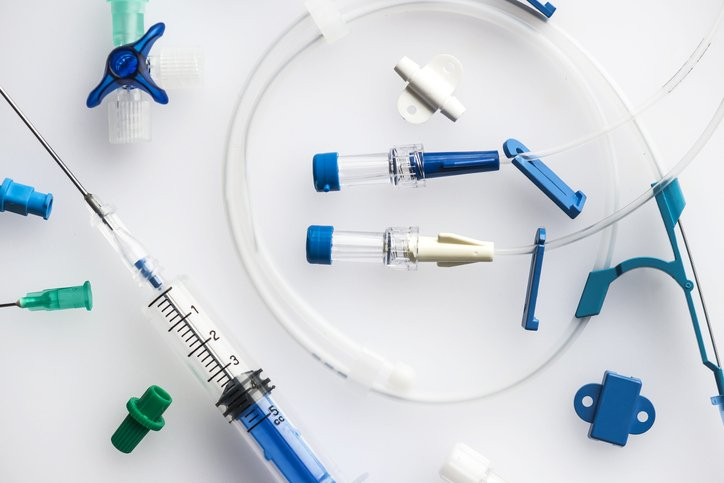When you’re developing a medical device, choosing the right plastic is a critical decision. It will affect everything from product safety to regulatory approval. Unlike general-purpose components, medical-grade parts face stricter demands. The materials you use must support biocompatibility, sterilization, mechanical integrity, and long-term stability.
A poor choice at this stage can lead to downstream issues: failed tests, production delays, or revalidation costs. That’s why understanding how to match materials with performance, compliance, and manufacturing needs is essential.
In this guide, you’ll learn what to consider when selecting plastics for medical device injection molding. The right decision upfront can save you time, money, and risk later on.

Why Material Selection Matters in Medical Device Molding
In medical device development, plastic is more than a structural material—it’s a functional component that must meet clinical, regulatory, and manufacturing requirements at once. You’re not just choosing based on strength or cost. The plastic must remain stable through sterilization, resist chemical exposure, and—if applicable—be safe for direct or indirect contact with the human body.
If you choose the wrong material, issues don’t always show up immediately. They often surface during validation: discoloration after gamma sterilization, cracking after repeated chemical exposure, or biocompatibility test failures that delay approval.
These problems don’t just impact part quality—they can force you to revisit mold design, restart compliance testing, or even halt production. That’s why material selection isn’t a side decision. It’s one of the most important choices you’ll make early in the project—and it has a lasting impact on how smoothly your product moves from prototype to market.
Key Properties to Consider When Selecting Plastics
Selecting materials for molded medical components requires more than checking mechanical strength or appearance. Each plastic must be evaluated based on how it performs under clinical, regulatory, and manufacturing conditions. The following six property categories should be considered when comparing material candidates:
1. Can It Safely Contact the Human Body? (Biocompatibility)
If your part comes into contact with skin, fluids, or tissue—even indirectly—you need to ensure the material meets biocompatibility standards. Look for plastics that conform to ISO 10993 or USP Class VI. These standards evaluate cytotoxicity, sensitization, and potential pyrogenicity.
Materials like polycarbonate (PC) and polypropylene (PP) are often used in external or short-duration contact devices. But don’t assume a plastic is safe just because it’s used elsewhere—always verify third-party testing or existing medical-grade certifications.
2. How Well Does It Handle Sterilization?
Your device will likely undergo some form of sterilization—ethylene oxide (EO), autoclaving (steam), or gamma irradiation. Each method affects materials differently. Some plastics may yellow, become brittle, or deform under heat or radiation.
Before committing, ask how the material holds up after multiple sterilization cycles. Medical-grade PEEK, PPSU, and PC often perform well, while others, like nylon, may require caution depending on the process.
3. Does It Have the Right Strength and Stability?
Mechanical performance matters whether your part is structural, load-bearing, or subject to repeated use. Look at impact resistance, flexural strength, and dimensional stability.
For housings or covers, ABS and PC/ABS blends offer a good balance of toughness and processability. For connectors or moving parts, PBT or nylon may be more suitable due to their fatigue strength and resilience under stress.
If your part has snap-fits, hinges, or tight interfaces, be sure the material can hold up without cracking or deforming.
4. Will It Resist Chemicals and Cleaners?
Medical plastics often face exposure to alcohol, disinfectants, or even drug formulations. Some materials degrade or swell under such contact, leading to cosmetic defects or even part failure.
Look for chemical resistance data from suppliers, especially for parts in IV systems, reagent handling, or fluid reservoirs. Polypropylene, PEEK, and PPSU are known for broad resistance, while others like ABS or polycarbonate may require surface coatings or additional protection.
5. Is Visual Clarity Important?
For parts like diagnostic housings, fluid containers, or device windows, you’ll need optical-grade clarity. Transparency allows for fluid monitoring, label visibility, and aesthetic appeal.
While polycarbonate is widely used, materials like COP (cyclic olefin polymer) and COC (cyclic olefin copolymer) offer better clarity, low birefringence, and excellent dimensional control, especially in microfluidic or lab-on-chip applications.
If visibility is essential, don’t just choose a “clear” plastic. Test for light transmission, haze, and color stability after sterilization.
6. Can It Be Molded Without Issues?
Some materials perform well in theory but are difficult to mold in practice. You’ll want to consider flowability, shrinkage rate, weld line strength, and release behavior. Poor processability can result in warping, sink marks, or excessive scrap rates, especially in complex geometries.
For example, PEI (polyetherimide) has excellent performance properties but requires tight processing control and precise tooling design. In contrast, ABS and PP are easier to mold and more forgiving in mass production.
Discuss molding behavior early with your supplier, particularly if the part involves thin walls, inserts, or undercuts.
By focusing on these six property areas, you’ll be able to filter down the long list of available plastics to a shortlist that meets both your technical goals and regulatory needs. The right material doesn’t just perform well—it supports a smoother, faster, and more reliable product development cycle.
Material Options Commonly Used in Medical Device Molding
When selecting plastics for medical molding, it’s helpful to understand the characteristics and limitations of commonly used materials. Below are several options frequently applied in diagnostic, therapeutic, and surgical device components.
| Material | Key Traits | Common Applications |
| Polypropylene (PP) | Resistant to chemicals and compatible with steam or EO sterilization. It also has good fatigue resistance. | Syringes, fluid reservoirs, caps |
| Polycarbonate (PC) | Offers high impact strength and optical clarity. Performs well in EO and gamma sterilization. | Device housings, diagnostic chambers |
| ABS | Easy to mold with good toughness and dimensional stability. Not suitable for high heat or repeated sterilization. | Monitor enclosures, handheld covers |
| Polyetherimide (PEI) | Withstands high temperatures and repeated steam sterilization. Rated for USP Class VI. | Surgical instrument handles, reusable parts |
| COC / COP | High transparency and low moisture absorption. Excellent for applications requiring optical precision. | Microfluidic chips, optical interfaces |
| PBT | Maintains dimensional stability and electrical insulation. Offers resistance to chemicals and humidity. | Connectors, sensor housings |
Each material serves different functional and regulatory needs. Selection should be based on a combination of application-specific requirements, sterilization method, and long-term performance in the intended environment.
Regulatory Requirements When Choosing Medical-Grade Plastics
Material selection for medical molding must align with regulatory expectations. Most devices require plastics that comply with ISO 10993 for biocompatibility or USP Class VI for biological reactivity. These standards assess factors such as cytotoxicity, sensitization, and systemic toxicity.
Using a material without proper certification increases project risk. It can lead to costly delays during validation or force you to conduct testing independently. Whenever possible, prioritize medical-grade resins that have established compliance records and supporting documentation.
Requesting material data sheets, regulatory declarations, and case-specific usage histories from suppliers is a practical step. These documents help verify whether the plastic has already been used in similar applications—and whether it meets the requirements of your intended use.
A material that has passed prior audits or validations can significantly reduce your time-to-market and streamline your documentation process.
Practical Considerations When Working with Suppliers
Selecting the right material is only part of the process. You also need to verify that your supplier understands the regulatory and processing requirements of medical applications.
- Work with distributors or molders who have experience in the medical field. They’re more likely to provide relevant documentation, anticipate approval challenges, and offer informed guidance on process parameters.
- Request material samples early, along with recommended molding settings such as melt temperature, drying time, and shrinkage range. This can help you avoid trial-and-error during tool validation.
- Check for consistency in material batches and long-term availability. Some resins may have limited production runs or contain additives that trigger regulatory review. A knowledgeable supplier of custom injection molding service can help you identify these risks before tooling begins.
Reliable communication and early-stage collaboration often prevent problems that surface later in development.
Conclusion
In medical device development, plastic selection is closely tied to performance, compliance, and long-term reliability. A material that meets basic functional needs may still fail under sterilization, chemical exposure, or regulatory review.
Your decision should be based on verified properties, documented certifications, and compatibility with molding processes. Evaluating these factors early helps reduce downstream risks, whether in validation, production, or market approval.
By aligning technical requirements with real-world manufacturing constraints, you can build a stronger foundation for safe, compliant, and scalable medical products.















